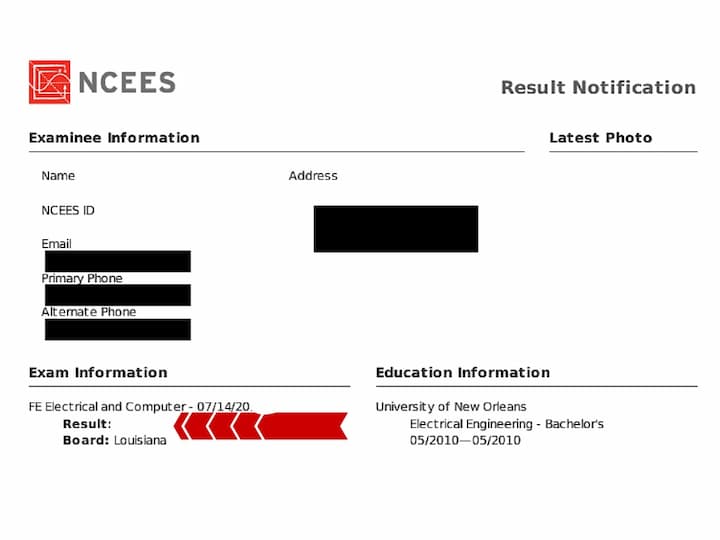By passing the FE exam and earning EIT certification, you will take the necessary steps to become a licensed professional engineer. Fully licensed professional engineers earn a higher salary than those who are not fully licensed. That is why adding this exam to your resume would be pretty beneficial.
Should I Really Put Passed FE Exam on Resume?
How is passed FE exam valued on a resume? Maybe, you just don`t need to waste time and put it.
Earning the Engineer in Training (EIT) designation is the first step in becoming a licensed professional engineer (PE). The FE exam is one of the requirements for obtaining the EIT designation. Many employers value the FE exam as it shows that you have the ability to perform at a high level and have a strong understanding of engineering principles. Therefore, including this information on your resume can be beneficial.
This exam is usually valued highly because it is an indication of your technical ability and engineering knowledge. If you have recently taken the FE exam and passed, definitely include this information on your resume. It will show prospective employers that you are serious about your career and have the skills to back it up.

If you have recently taken and passed the FE exam, you may be wondering how to list it on your resume. Here we will provide you with a few tips on how to do it more efficiently.
How hard is FE exam?
To understand how high is this exam valued, you should know what are its requirements. The FE exam is a computer-based test that lasts six hours. The FE Exam tests your ability to apply and integrate your knowledge of mathematics, probability and statistics, chemistry, physics, ethics, and business practices in order to perform well as an entry-level engineer. It consists of 110 multiple-choice questions, divided into two sections: morning and afternoon.
The morning section covers general engineering topics, while the afternoon section covers specific disciplines. You will be given a choice of four disciplines to select from chemical, civil, electrical/computer, or mechanical engineering. You must pass both sections of the exam to earn your EIT certification.
What Section Should You Use?
In general, a good resume consists of four main sections:
- Contact information
- Objective statement
- Education
- Work experience
- Skills
- References

Of course, the most obvious position of the passed FE exam would be under the Education section. That is because usually all courses and exams that helped you to get your degree are mentioned there. Including the FE exam in the Education section is definitely a good idea but if you want to highlight it even more, you can create a separate section for it and name it “Professional Development” or “Relevant Coursework”. Usually, these sections are filled with internships, research projects, and other extracurricular activities that helped you to gain some experience in your field.
If you have a lot of work experience, you can also include the FE exam under the “Professional Development” section. In this case, it would be listed together with your professional development activities and courses. Creating a separate section has one more advantage. It allows you to put more emphasis on the fact that you have passed the FE exam by adding a few sentences about its difficulty level or what made you take it in the first place.
What Should You Write About the FE Exam?
Usually, depending on the section you include it in, you would want to write either a brief description or just the name of the exam and the date when you took it. If you decide to create a separate section, we would recommend writing a brief description of the FE exam.
In this description, you can mention that it is required for licensure in many states, that it covers various topics such as mathematics, engineering probability, and statistics, or that it is one of the exams required for the EIT designation. You can also add a sentence about how long the exam is or how many questions are on it.

If you decide to include the FE exam under the Education section, simply listing the name of the exam and the date when you took it would be enough.
When it comes to formatting, there is no one right way to do it. It all depends on how you want your resume to look and what other information you include in it. However, we would recommend using a simple and easy-to-read format such as bullet points.
Here are a few examples of how you can list the FE exam on your resume:
Education:
• B.S. in Civil Engineering, XYZ University (2016)
• FE Exam – Passed (2017)
Relevant Coursework:
• Introduction to Environmental Engineering (2016)
• Engineering Probability and Statistics (2017)
• FE Exam – Passed (2017)
Professional Development:
• Internship at ABC Company (2015)
• FE Exam – Passed (2017)
As you can see, there are many ways in which you can list the FE exam on your resume. The most important thing is to make sure that the information is easy to find and understand.
Of course, you can adjust this example to fit your own situation. It all depends on what other information you want to include and where you want to put more emphasis. In any case, don`t forget to mention that you have passed the exam as it will definitely be looked upon favorably by potential employers.
How Can You Highlight the Resume?
Adding certain courses sometimes is not enough when we want to make it more attractive in the eyes of recruiters. If you decide to put the FE exam on your resume, you can do a few things to make it stand out even more.
Here are some tips:
- Use a simple but professional format
- Use clear and easy-to-read font sizes
- Highlight the name of the exam or add a logo
- Use bold or italics for the date when you took the exam
- Add a brief description of the exam under the Education or Professional Development section
It sounds very basic and straightforward, but making your resume look good is essential if you want to catch the attention of potential employers. By following these tips, you will make sure that the information about your FE exam is easily visible and that it won`t get lost in the rest of the content.
FAQ
Do you put EIT after your name?
When an individual passes the required exam, they receive either an Engineer-in-Training (EIT) or Engineer Intern (EI) designation from the state board. EIT and EI are both equivalent titles that simply differ based on the state you reside in. For example, in Texas and Florida, the title is EIT, whereas in California, Colorado, and Illinois, the title is Engineer Intern.
Putting the passed FE exam right after your name may be beneficial if you want to show that you are taking active steps towards becoming a licensed engineer. However, it is not necessary and it is ultimately up to you whether or not you want to include it.
How many people pass the FE exam?
Overall, the pass rate is about 62% for FE Civil, which means that more than half of the people who take the exam fail. This number may seem discouraging, but it is important to remember that the FE exam is not an easy test. It covers a wide range of topics, and it requires a lot of dedication and hard work to pass.

If you are planning on taking the FE exam, we would recommend that you start studying well in advance. There are many resources available online and in libraries that can help you prepare for the exam.
Does FE exam expire?
The Engineer intern certification means you’ve successfully completed the national Fundamentals of Engineering (FE) exam and is valid indefinitely. This means that you do not need to retake the FE exam, even if you do not work as an engineer for several years.
The answer to this question really depends on the state in which you are licensed. In some states, the license expires after a certain number of years, and you will need to take the FE exam again in order to renew it. However, in other states, the license does not expire and you will not need to retake the exam.
